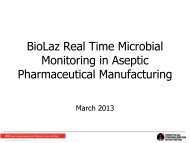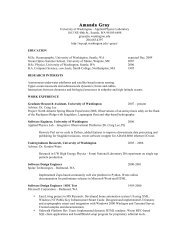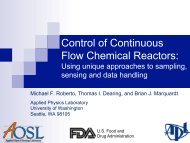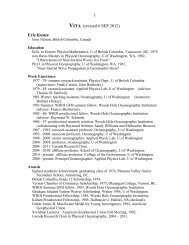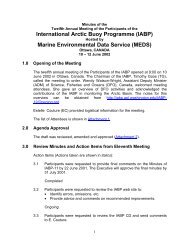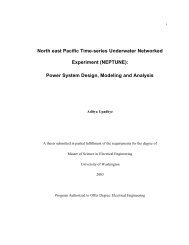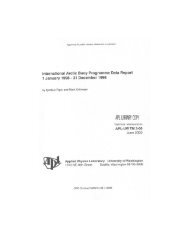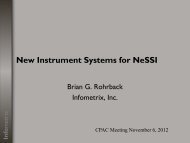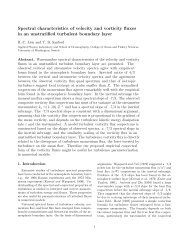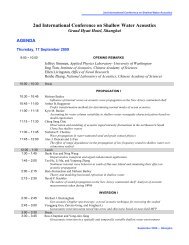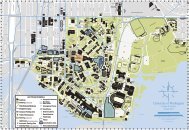Design of Simulated Moving Bed Chromatography - CPAC
Design of Simulated Moving Bed Chromatography - CPAC
Design of Simulated Moving Bed Chromatography - CPAC
Create successful ePaper yourself
Turn your PDF publications into a flip-book with our unique Google optimized e-Paper software.
<strong>Simulated</strong> <strong>Moving</strong> <strong>Bed</strong> <strong>Chromatography</strong><br />
for Insulin Purification:<br />
<strong>Design</strong> Methods and Simulation Tools to<br />
Achieve High Product Purity and High<br />
Yield<br />
George Weeden and N-H. Linda Wang<br />
School <strong>of</strong> Chemical Engineering<br />
Purdue University
Overview<br />
• <strong>Chromatography</strong> and SMB<br />
– Principles<br />
– Key Barriers<br />
• Purdue SMB Technologies<br />
– Standing Wave <strong>Design</strong> & Optimization<br />
– VERSE Dynamic Simulations<br />
– Versatile SMB Equipment (V SMB)<br />
– Knowledge- Based <strong>Design</strong> Method<br />
• Examples<br />
– Tandem SMB for insulin purification<br />
– Five-zone SMB to recover six sugars from biomass<br />
hydrolysate
CONVENTIONAL CHROMATOGRAPHY<br />
A Batch Process<br />
Eluent<br />
Feed<br />
Pre-equilibration<br />
Adsorbent<br />
Particles<br />
3
<strong>Chromatography</strong>-Advantages<br />
• High selectivity – 1 in 10,000.<br />
• Compact volume compared to extraction.<br />
• Lower solvent usage than extraction.<br />
• Mild operating conditions – suitable for<br />
fragile compounds.<br />
• Versatile mechanisms <strong>of</strong> separation –<br />
adsorption, ion exchange, size exclusion,<br />
etc.
Mechanisms <strong>of</strong> Adsorption
Limitations <strong>of</strong> Batch <strong>Chromatography</strong> for<br />
Production<br />
• Difficult to achieve both high purity<br />
and high yield<br />
• Low adsorbent utilization<br />
• High solvent consumption<br />
• Product dilution<br />
• Not a continuous process<br />
• High cost
Solution I- Binary Separation in a<br />
Continuous <strong>Moving</strong> <strong>Bed</strong>
Solution II–<strong>Moving</strong> Port or SMB<br />
Desorbent<br />
1<br />
ZONE I<br />
2<br />
Extract<br />
8<br />
Solute<br />
Movement<br />
3<br />
ZONE IV<br />
7<br />
Step N<br />
ZONE III<br />
4<br />
ZONE II<br />
Raffinate<br />
6<br />
5<br />
Feed
Advantages <strong>of</strong> SMB over Batch<br />
• Only partial separation <strong>of</strong> solutes is required to<br />
obtain high purity.<br />
• Higher yield than batch – 10% more than batch.<br />
• High purity achievable without sacrificing yield.<br />
• High productivity– 5 to 10 fold increase.<br />
• Less solvent – 5 to 10 fold less.<br />
• Reduced environment impact.<br />
• Reduced footprint, equipment size, and manpower.<br />
• Continuous process-high throughput.<br />
• Economical for large scale separations.
Commercial Applications <strong>of</strong> SMB<br />
• Hydrocarbons – UOP (Molex, Parex)<br />
(1970’s)<br />
• Sugars – Tate & Lyle (1980’s)<br />
• Chiral Drugs (1990’s)<br />
• All binary separations <strong>of</strong> low MW<br />
chemicals in four-zone SMB
Key Barriers in SMB<br />
• A four-zone SMB has 9 design parameters - 2 9 to 3 9<br />
trials.<br />
• Many system & operating parameters to be optimized.<br />
• Method for multi-component separation not well<br />
developed.<br />
• Complex transient and cyclic steady state phenomena.<br />
• Equipment more complex than batch chromatography.<br />
• No commercial equipment for multi-component<br />
separation.<br />
• Control <strong>of</strong> batch identity and residence time<br />
• Experiments expensive and time-consuming
Purdue’s Platform SMB Technologies<br />
1. Standing Wave <strong>Design</strong> and<br />
Optimization.<br />
2. VERSE simulations.<br />
3. Versatile SMB equipment.<br />
4. A systematic knowledge-based<br />
method for process design and<br />
optimization.
Conc.<br />
Standing Wave <strong>Design</strong>: Binary, Ideal, Linear Systems<br />
Desorbent<br />
Feed<br />
I II III IV<br />
Extract<br />
<strong>Bed</strong> Position<br />
Raffinate<br />
=<br />
= u<br />
= u<br />
= u<br />
F<br />
u<br />
Feed<br />
I<br />
w,slow<br />
II<br />
w,fast<br />
III<br />
w,slow<br />
IV<br />
w,fast<br />
=<br />
Sε<br />
b<br />
<br />
u<br />
III<br />
0<br />
u<br />
II<br />
0<br />
<br />
u w,i<br />
a<br />
= u 0<br />
a<br />
/ ( 1 + Pd i )<br />
= wave velocity <strong>of</strong> component i in zone a<br />
= L c / t s = port movement velocity<br />
F feed = feed flow rate<br />
u 0<br />
a<br />
= interstitial velocity in zone a<br />
e b = inter-particle void fraction<br />
P = (1 – e b ) / e b = bed phase ratio<br />
d i = distribution coefficient <strong>of</strong> i<br />
S = column cross-sectional area
Conc.<br />
Standing Wave <strong>Design</strong>- Linear, Non-ideal Systems<br />
Desorbent<br />
Desorption wave <strong>of</strong> Low affinity<br />
solute confined in Zone II<br />
Feed<br />
Adsorption wave <strong>of</strong> Low affinity<br />
solute confined in Zone IV<br />
Zone I Zone II Zone III Zone IV<br />
Extract<br />
<strong>Bed</strong> Position<br />
Raffinate<br />
•Ideal System: Matching wave velocities with port<br />
velocity to ensure high purity and yield<br />
•Non-ideal Systems: Difference in wave velocity and<br />
port velocity allows wave focusing in each zone
Concentration<br />
Standing Wave <strong>Design</strong>: Multi-Component System<br />
with Mass Transfer Effects<br />
Desorbent<br />
Feed<br />
(1, 2, 3)<br />
I II III IV<br />
*<br />
1 Fast Solute<br />
2 Intermediate<br />
3 Slow Solute<br />
Extract<br />
(2, 3)<br />
<strong>Bed</strong> Position<br />
*<br />
Raffinate<br />
(1)<br />
*<br />
Focused Standing Wave<br />
Pinched Wave
Standing Wave <strong>Design</strong> & Optimization-<br />
Advantages<br />
• Four zone flow rates and port velocity are<br />
solved easily.<br />
• Little computation time required.<br />
• Easy extension to nonlinear, multicomponent,<br />
multi-zone separations.<br />
• Achieving maximum productivity and<br />
minimum solvent consumption for a given<br />
configuration.<br />
• Reduce search space by five dimensions or<br />
more for optimization.
VErsatile Reaction SEparation Simulator (VERSE)<br />
Mechanisms<br />
.<br />
Fluid<br />
Bulk<br />
Fluid<br />
Bulk Convection<br />
Adsorption<br />
Sites<br />
Reaction<br />
Adsorption<br />
Film<br />
Diffusion<br />
Interference<br />
Ion<br />
Exchange<br />
Pore<br />
Diffusion<br />
Sorbent<br />
Particle<br />
Denaturation<br />
Size<br />
Exclusion<br />
Surface<br />
Diffusion<br />
Fluid<br />
Solid<br />
Phase<br />
Reaction<br />
Pore<br />
Fluid
VERSE<br />
VErsatile Reaction SEparation Simulator<br />
• Simulation based on a detailed dynamic rate model<br />
(transient differential mass balances)<br />
• Thousands <strong>of</strong> equations solved at each instance<br />
• To predict column pr<strong>of</strong>iles and histories<br />
• To understand transient phenomena in batch<br />
chromatography, carousel, and SMB<br />
• To understand residence time and batch integrity<br />
issues in SMB<br />
• To reduce the number <strong>of</strong> costly experiments
Versatile SMB<br />
To implement complex processes for multicomponent<br />
separations<br />
Valve Controls<br />
Valves<br />
Sephadex<br />
G50 Columns<br />
Pumps
Features <strong>of</strong> Versatile SMB<br />
• Dedicated valves and manifolds for high purity<br />
and high yield<br />
• Allows zone bypass, open loop, multizone,<br />
multisolvent ,and multicomponent separation.<br />
• Easy column expansibility.<br />
• <strong>Moving</strong> port chromatography.<br />
• Online decoupled regeneration (Animation)<br />
• Independent column switching for variable step<br />
time
Knowledge-Based <strong>Design</strong> & Optimization<br />
Engineering<br />
Parameters<br />
Mobile Phase, pH,<br />
Stationary Phase,<br />
Temperature<br />
Process <strong>Design</strong> &<br />
Optimization<br />
VERSE<br />
Simulator<br />
Experimental<br />
Verification<br />
Batch or<br />
V-SMB Exp<br />
Solubility,<br />
Capacity,<br />
Selectivity<br />
Elution Pr<strong>of</strong>ile,<br />
Purity, Yield,<br />
Concentration,<br />
Productivity<br />
Elution Pr<strong>of</strong>ile,<br />
Purity, Yield,<br />
Concentration,<br />
Productivity<br />
Pulse,<br />
Frontal<br />
Voidage,<br />
Isotherm,<br />
Mass Transfer,<br />
Numerical<br />
Parameters<br />
SWD,<br />
Scale-Up,<br />
Optimization<br />
Sensitivity,<br />
Trade-<strong>of</strong>f<br />
Optimal<br />
<strong>Design</strong><br />
Optimal<br />
Process<br />
(Hirtzko et al., 1999; Mun et al., 2005; Wu et al., 1997; Xie et al., 2002)
Novel Purdue SMB Processes<br />
• Pilot Scale Separations<br />
– Insulin from zinc chloride and protein<br />
impurities<br />
– Six sugars from biomass hydrolysate (>10<br />
components)<br />
• Lab Scale<br />
– Antibiotic Drug<br />
– Amino Acids and Derivatives<br />
– Lactic Acid<br />
– Paclitaxel (anticancer drug )<br />
– Chiral Drugs
Knowledge-Based <strong>Design</strong> <strong>of</strong><br />
Tandem SMB for Insulin Purification
Biosynthetic Human Insulin (BHI) Process<br />
Recombinant E. coli.<br />
Trp proinsulin<br />
Proinsulin<br />
Crude insulin<br />
Homogenization<br />
Cleavage, oxidative sulfitolysis, folding<br />
Enzymatic transformation<br />
Ion-exchange<br />
Reversed-Phase HPLC<br />
Size exclusion chromatography (SEC)<br />
Purified BHI<br />
Crystallization<br />
Isolation & purification steps take 10 to 12 weeks.
Conventional Size Exclusion <strong>Chromatography</strong><br />
1<br />
0.8<br />
Insulin<br />
(Product)<br />
C/CF<br />
0.6<br />
0.4<br />
Proinsulin /<br />
HMWP<br />
Fronting<br />
Zinc<br />
Chloride<br />
0.2<br />
0<br />
Proinsulin / HMWP<br />
Insulin (Product)<br />
Zinc Chloride<br />
Animation<br />
0 100 200 300<br />
Volume (L)<br />
BHI exp. HPI exp. HPI sim.<br />
• Existing SEC batch process<br />
ZnCl2 exp. BHI sim. ZnCl2 sim.<br />
• Yield < 90%<br />
• Purity >99%<br />
• Resin throughput = 0.23 L / hr/100 L BV
Tandem SMB for Insulin Purification<br />
ELUENT<br />
EXTRACT ( )<br />
ELUENT<br />
EXTRACT ( )<br />
FEED ( )<br />
FEED ( )<br />
RAFFINATE ( )<br />
RAFFINATE ( )<br />
HMWP<br />
Insulin<br />
Zinc Chloride
SMB Experimental Validation : Ring I<br />
C/CF<br />
1<br />
0.8<br />
0.6<br />
0.4<br />
0.2<br />
(b) Effluent histories at the extract port<br />
HMWP exp.<br />
HMWP sim.<br />
Insulin exp.<br />
Insulin sim.<br />
ZnCl2 exp.<br />
ZnCl2 sim.<br />
C/CF<br />
1<br />
0.8<br />
0.6<br />
0.4<br />
0.2<br />
(a) Effluent histories at the raffinate port<br />
Insulin exp.<br />
Insulin sim.<br />
HMWP exp.<br />
HMWP sim.<br />
ZnCl2 exp.<br />
ZnCl2 sim.<br />
0<br />
0 10 20 30 40 50<br />
Switching Step<br />
0<br />
0 10 20 30 40 50<br />
Switching Step<br />
(c) Mid-step column pr<strong>of</strong>iles at cyclic steady state<br />
Desorbent Extract Feed Raffinate<br />
1.2<br />
0.9<br />
Zone I<br />
Zone II<br />
Zone III<br />
Zone IV<br />
Insulin exp.<br />
Insulin sim.<br />
C/CF<br />
0.6<br />
HMWP exp.<br />
HMWP sim.<br />
0.3<br />
ZnCl2 exp.<br />
ZnCl2 sim.<br />
0<br />
0 1 2 3 4 5 6 7 8 9 10<br />
Column number
SMB Experimental Validation: Ring II<br />
C/CF<br />
1<br />
0.8<br />
0.6<br />
0.4<br />
0.2<br />
0<br />
(b) Effluent histories at the extract port<br />
0 20 40 60<br />
Switching Step<br />
Insulin exp.<br />
Insulin sim.<br />
ZnCl2 exp.<br />
ZnCl2 sim.<br />
(c) Mid-step column pr<strong>of</strong>iles at cyclic steady state<br />
Desorbent Extract Feed Raffinate<br />
1.2<br />
Zone I<br />
Zone II<br />
Zone III<br />
Zone IV<br />
C/CF<br />
0.9<br />
0.6<br />
0.3<br />
Insulin exp.<br />
Insulin sim.<br />
ZnCl2 exp.<br />
ZnCl2 sim.<br />
0<br />
0 1 2 3 4 5 6 7 8 9 10<br />
Column number
Parameter (5,000 kg insulin /<br />
year)<br />
Batch Xie (2002) Overall Optimized SMB<br />
Overall Yield (%) 89 99 99<br />
Column<br />
Configuration<br />
Ring A<br />
2-2-4-2 2-2-4-2<br />
12 in series<br />
Ring B 2-3-3-2 2-2-2-2<br />
Feed Flowrate (mL/min) 11 (each) 115 115<br />
Column Length (cm)<br />
Diameter (cm)<br />
Ring A<br />
13.7 9.34<br />
15<br />
Ring B 13.7 7.02<br />
Ring A 45<br />
47.9 27.2<br />
Ring B (12 units) 58.6 42.6<br />
Throughput (L/h/100 L BV) .23 1.19 5.36<br />
Solv. consumption (L/kg insulin) 150 42 55.6<br />
Equip. Cost ($/kg insulin) 35.71 29.76 29.17<br />
Solv. Cost ($/kg insulin) 15 4.20 5.56<br />
Resin Cost ($/kg insulin) 40.07 7.41 1.61<br />
Total Cost ($/kg) 90.78 41.50 36.35
SEC-SMB for Insulin Purification<br />
• Lab-scale tandem SMB designed and validated<br />
with experiments<br />
• 99% yield, 5X throughput, and 1/3 solvent<br />
consumption<br />
• Robust and optimal process-scale operation<br />
designed to increase throughput by 20X.<br />
• Novel strategies created to reduce protein<br />
residence time and maintain batch identity<br />
31
<strong>Design</strong> &<br />
Optimization<br />
(Mun et al., IEC Res 2003)<br />
Startup &<br />
Shutdown<br />
(Xie et al.,<br />
IEC Res 2003)<br />
Key Issues Solved<br />
Splitting<br />
Strategies<br />
(Hritzko et al., AICHE J 2002)<br />
Experimental<br />
Validation<br />
(Xie et al., Biotech Prog 2002)<br />
SMB<br />
High Purity<br />
High Yield<br />
Low Cost<br />
Robust<br />
Operation<br />
(Mun et al.,<br />
IEC Res 2003)<br />
Insulin<br />
Aggregation<br />
(Yu et al., JCIS 2006)<br />
Periodic<br />
Regeneration<br />
(Xie et al., WCCBME 2003)<br />
Residence<br />
Time<br />
(Mun et al.,<br />
AICHE J 2003)<br />
Versatile<br />
SMB<br />
(Chin & Wang,<br />
Sep Purif Rev 2004)<br />
Batch<br />
Identity<br />
(Mun et al.,<br />
Biotech Prog 2004)
Conclusions<br />
• Purdue SMB technologies<br />
–S<strong>of</strong>tware tools for design, simulation,<br />
and optimization.<br />
–Versatile SMB equipment for multicomponent<br />
separation.<br />
• Useful for developing high purity, high<br />
yield separations <strong>of</strong> chemicals,<br />
biochemicals, and pharmaceuticals.
Acknowledgements<br />
• Eli Lilly Co.<br />
• 21 st Century Indiana Research and Technology<br />
Fund (28)<br />
• Department <strong>of</strong> Energy (DE-FC36-01GO11071)<br />
• Purdue TTI-IRL (NSF IGERT 9987576)<br />
• SWD: Z. Ma, Y. Xie, K.B. Lee<br />
• VERSE: R. Whitely, Y. Xie<br />
• V-SMB equipment: C. Chin<br />
• Insulin Purification: Y. Xie, S. Mun, C. Chin



